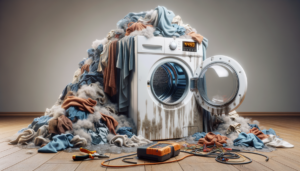Appliances play a crucial role in our daily lives, making our tasks easier and more convenient. From refrigerators to washing machines, these appliances have become an integral part of our homes. However, like any other machine, appliances are prone to wear and tear over time. This is where appliance repair and maintenance come into play.
Regular maintenance and timely repairs are essential to ensure the longevity and efficiency of your appliances. Neglecting these tasks can lead to costly repairs or even the need for replacement. By understanding the basics of appliance repair and maintenance, you can save money, extend the lifespan of your appliances, and avoid unnecessary inconveniences.
Key Takeaways
- Understanding the basics of appliance repair can save you time and money in the long run.
- Proper maintenance is key to preventing frequent repairs and extending the lifespan of your appliances.
- Essential tools such as multimeters, screwdrivers, and pliers are necessary for efficient appliance repair.
- Troubleshooting techniques such as checking for power supply and examining mechanical components can help diagnose common appliance issues.
- Understanding electrical and mechanical components is crucial for successful appliance repair and avoiding potential hazards.
Understanding the Basics of Appliance Repair
A. Types of Appliances
There are various types of appliances found in households, each serving a specific purpose. Some common types include refrigerators, washing machines, dryers, dishwashers, ovens, and microwaves. Each appliance has its own set of components and mechanisms that may require repair or maintenance at some point.
B. Common Issues
Appliances can experience a range of issues, from minor malfunctions to major breakdowns. Some common issues include leaks, strange noises, failure to start or turn on, overheating, poor performance, and electrical problems. Identifying the specific issue is crucial in determining the appropriate repair method.
C. Tools Needed
To perform appliance repairs effectively, you will need a set of tools specifically designed for this purpose. Some essential tools include screwdrivers (both flathead and Phillips), pliers, wrenches, nut drivers, wire cutters/strippers, multimeter for testing electrical connections, and various other specialized tools depending on the appliance being repaired.
Proper Maintenance to Prevent Frequent Repairs
A. Cleaning and Care
Regular cleaning is essential for maintaining the performance and efficiency of your appliances. This includes cleaning filters, removing debris, and wiping down surfaces. For example, in a refrigerator, cleaning the condenser coils and defrosting the freezer regularly can prevent issues such as overheating and poor cooling.
B. Regular Inspections
Performing regular inspections can help identify potential issues before they become major problems. Check for loose connections, worn-out parts, leaks, and any signs of damage. By catching these issues early on, you can prevent further damage and costly repairs.
C. Replacement of Parts
Over time, certain parts of your appliances may wear out or become damaged. It is important to replace these parts promptly to avoid further damage or breakdowns. This may involve ordering replacement parts from the manufacturer or consulting a professional repair service.
Essential Tools for Efficient Appliance Repair
A. Hand Tools
Hand tools are essential for basic appliance repairs and maintenance tasks. These include screwdrivers, pliers, wrenches, nut drivers, and wire cutters/strippers. These tools allow you to disassemble and reassemble components, tighten or loosen screws, and perform other necessary tasks.
B. Power Tools
Power tools can be useful for more complex repairs or tasks that require more force or precision. These may include drills, impact drivers, reciprocating saws, and rotary tools. However, it is important to use power tools with caution and follow safety guidelines to avoid accidents or damage to the appliance.
C. Testing Equipment
Testing equipment such as a multimeter is crucial for diagnosing electrical issues in appliances. This tool allows you to measure voltage, current, and resistance in electrical circuits. By using a multimeter, you can identify faulty connections or components and determine the appropriate repair method.
Troubleshooting Techniques for Common Appliance Issues
A. Electrical Issues
Electrical issues are common in appliances and can range from simple wiring problems to more complex circuitry malfunctions. Troubleshooting electrical issues involves checking for loose connections, damaged wires, blown fuses, or faulty switches. Using a multimeter can help identify the specific electrical problem.
B. Mechanical Issues
Mechanical issues in appliances often involve moving parts, such as motors, belts, or gears. These issues can cause strange noises, poor performance, or complete breakdowns. Troubleshooting mechanical issues involves inspecting and testing these components for wear and tear, misalignment, or damage.
C. Common Solutions
Once the specific issue has been identified, it is important to determine the appropriate solution. This may involve repairing or replacing faulty components, adjusting settings or controls, cleaning or lubricating moving parts, or performing other necessary tasks. Following repair manuals or consulting professionals can provide guidance on the best solutions for specific appliances.
Understanding Electrical and Mechanical Components
A. Electrical Components
Electrical components in appliances include switches, relays, motors, capacitors, resistors, and wiring. These components are responsible for powering and controlling various functions of the appliance. Understanding how these components work and interact with each other is crucial for effective troubleshooting and repair.
B. Mechanical Components
Mechanical components in appliances include motors, belts, pulleys, gears, valves, and fans. These components are responsible for the movement and operation of different parts of the appliance. Understanding how these components function and interact with each other is essential for diagnosing and repairing mechanical issues.
C. How They Work Together
Electrical and mechanical components work together to ensure the proper functioning of appliances. For example, in a washing machine, the motor powers the drum to rotate while the electrical controls regulate the water temperature and cycle settings. Understanding how these components work together allows for more efficient troubleshooting and repair.
Tips for Safe Appliance Repair
A. Safety Precautions
Safety should always be a top priority when performing appliance repairs. This includes wearing protective gear such as gloves and safety glasses, working in a well-ventilated area, and following safety guidelines provided by the manufacturer. It is also important to disconnect the appliance from the power source before starting any repair work.
B. Proper Handling of Tools
Using tools properly and safely is crucial to avoid accidents or damage to the appliance. This includes using the correct tool for the task, ensuring tools are in good condition, and following proper techniques for handling and operating tools. It is also important to store tools safely to prevent injuries or damage.
C. Electrical Safety
When working with electrical components, it is important to take extra precautions to avoid electrical shocks or fires. This includes turning off the power source, using insulated tools, and avoiding contact with live wires or exposed electrical parts. If unsure about electrical repairs, it is best to consult a professional.
Replacing Faulty Parts: What You Need to Know
A. Identifying Faulty Parts
Identifying faulty parts in appliances can be challenging, especially for complex systems. However, by understanding how the appliance functions and conducting thorough inspections, you can narrow down the potential faulty components. Testing equipment such as a multimeter can also help identify faulty electrical components.
B. Finding Replacement Parts
Once a faulty part has been identified, finding a suitable replacement is crucial for effective repair. This may involve ordering parts directly from the manufacturer or consulting local appliance repair shops. It is important to ensure that the replacement part matches the specifications of the original part to ensure compatibility and proper functioning.
C. Installation Tips
Proper installation of replacement parts is essential for effective repair and preventing further damage. This may involve following installation instructions provided by the manufacturer or consulting repair manuals. It is important to handle replacement parts with care and ensure they are installed correctly to avoid issues such as leaks, poor performance, or electrical problems.
Cleaning and Servicing Appliances for Optimal Performance
A. Cleaning Techniques
Regular cleaning of appliances is essential for maintaining optimal performance and efficiency. This includes cleaning filters, removing debris, and wiping down surfaces. Specific cleaning techniques may vary depending on the appliance. For example, in a dishwasher, cleaning the spray arms and removing food particles from the filter can improve cleaning performance.
B. Servicing Tips
Servicing appliances involves more in-depth maintenance tasks such as lubricating moving parts, adjusting settings or controls, and inspecting for wear and tear. This may require disassembling certain components or accessing hard-to-reach areas. Following manufacturer guidelines or consulting professionals can provide guidance on specific servicing tasks.
C. Maintenance Schedules
Establishing a regular maintenance schedule for your appliances can help prevent issues and extend their lifespan. This may involve performing certain tasks monthly, quarterly, or annually, depending on the appliance and its usage. Keeping track of maintenance schedules and performing tasks consistently can ensure optimal performance and efficiency.
How to Diagnose and Fix Refrigeration Problems
A. Common Refrigeration Issues
Refrigerators are one of the most important appliances in our homes, keeping our food fresh and safe to consume. Common refrigeration issues include poor cooling, leaks, strange noises, ice buildup, and faulty temperature control. Diagnosing these issues involves inspecting components such as the compressor, condenser coils, evaporator fan, and defrost system.
B. Troubleshooting Techniques
Troubleshooting refrigeration issues involves checking for common causes such as blocked vents, dirty condenser coils, or faulty temperature sensors. It may also involve testing electrical connections or using a multimeter to measure voltage or resistance in specific components. Following repair manuals or consulting professionals can provide guidance on specific troubleshooting techniques.
C. Repairing Refrigeration Components
Repairing refrigeration components may involve replacing faulty parts such as the compressor, condenser fan motor, defrost heater, or temperature control thermostat. It is important to follow proper installation techniques and handle refrigerant properly to avoid leaks or damage. If unsure about refrigeration repairs, it is best to consult a professional.
Repairing Small Appliances: A Step-by-Step Guide
A. Types of Small Appliances
Small appliances include devices such as toasters, blenders, coffee makers, and vacuum cleaners. These appliances are often simpler in design and easier to repair compared to larger appliances. However, they can still experience issues such as power failures, broken switches, or clogged filters.
B. Common Issues
Common issues in small appliances include power failures, faulty switches or controls, broken cords, or clogged filters. Diagnosing these issues involves inspecting the specific components and testing electrical connections if necessary.
C. Repair Techniques
Repairing small appliances often involves replacing faulty parts such as switches, cords, or filters. It may also involve cleaning or lubricating moving parts or adjusting settings or controls. Following repair manuals or consulting professionals can provide guidance on specific repair techniques for different small appliances.
The Importance of Appliance Repair and Maintenance for Longevity and Efficiency.
In conclusion, appliance repair and maintenance are essential for ensuring the longevity and efficiency of your appliances. By understanding the basics of appliance repair, performing regular maintenance tasks, and following proper troubleshooting and repair techniques, you can save money, extend the lifespan of your appliances, and avoid unnecessary inconveniences. It is important to prioritize safety when performing appliance repairs and to consult professionals if unsure about specific tasks. By taking care of your appliances and addressing issues promptly, you can enjoy their benefits for years to come.
How Can Efficient Cleaning Techniques Help in the Repair of Appliances?
Efficient appliance cleaning tips can significantly contribute to the repair of appliances by preventing issues caused by buildup or neglect. Regular cleaning of appliances can help improve their performance, extend their lifespan, and reduce the need for costly repairs. Proper maintenance is essential for optimal functionality.
FAQs
What are some common appliance repair techniques?
Some common appliance repair techniques include cleaning, replacing faulty parts, adjusting settings, and performing routine maintenance.
What are some tips for efficient appliance repair?
Some tips for efficient appliance repair include identifying the problem before attempting to fix it, using the proper tools and equipment, following manufacturer instructions, and seeking professional help if necessary. Additionally, keeping an organized workspace can enhance your efficiency and safety during the repair process. Remember that when faced with particularly challenging issues, seeking assistance from a professional—like the Maytag repair man as an icon—can save time and ensure that repairs are done correctly. Regular maintenance and timely inspections can also prevent future problems, making appliance ownership a smoother experience. Additionally, keeping a record of previous repairs can help in understanding recurring issues and finding long-lasting solutions. When hiring a professional, it’s also beneficial to focus on negotiating repair estimates for appliances to ensure you receive a fair price. Doing some research on average costs for specific repairs can empower you to advocate effectively for yourself.
What are some common appliance problems that can be fixed?
Some common appliance problems that can be fixed include clogged filters, faulty thermostats, broken belts, and malfunctioning motors.
What are some signs that an appliance needs repair?
Some signs that an appliance needs repair include strange noises, unusual smells, poor performance, and visible damage.
Can I repair my own appliances?
It is possible to repair your own appliances, but it is important to have the proper knowledge, tools, and experience. If you are unsure about how to repair an appliance, it is best to seek professional help.
How can I prevent appliance problems?
You can prevent appliance problems by performing routine maintenance, cleaning regularly, using appliances properly, and addressing any issues as soon as they arise.



